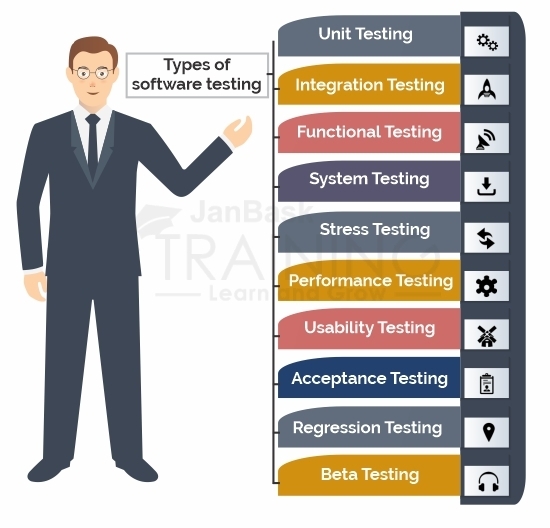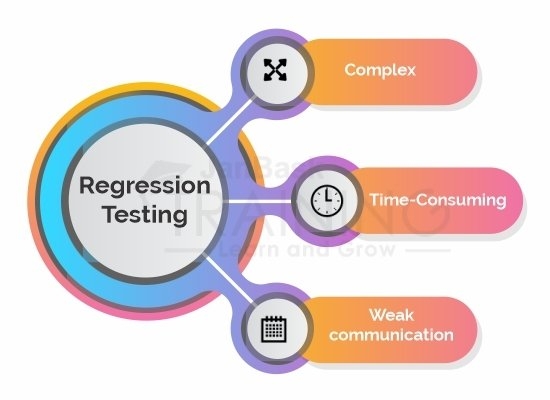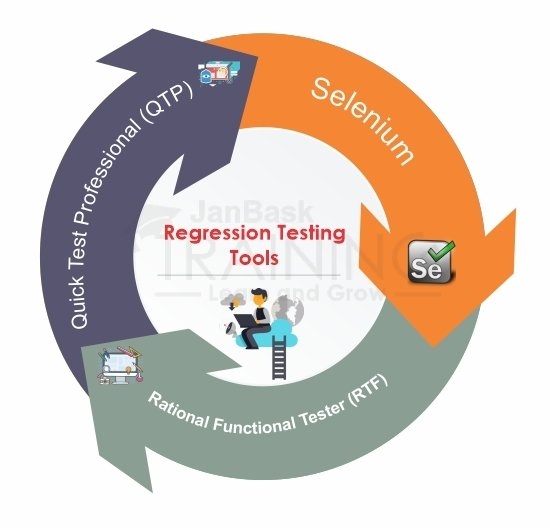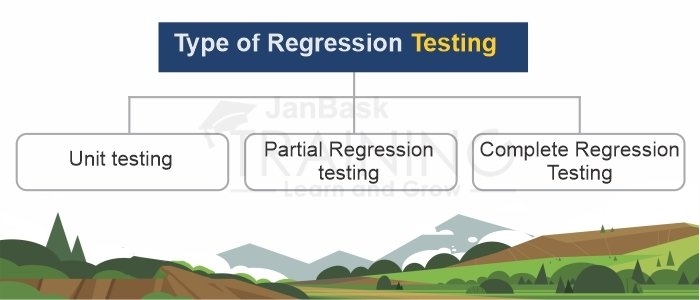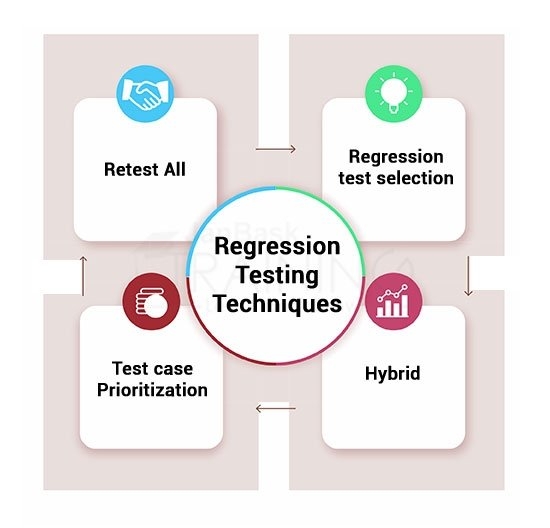Introduction
We live in an era of technology where software programs and applications have become an important part of our lives. When a software program is created, it is not simply released, but it has to go through different types of software testing before the final deployment. The software testing process validates or verifies a software product from technical and functional prospects.
Enroll in a professional Software Testing Program to make yourself job-ready and learn all the major topics!

The software testing ensures the product is working the same way for which purpose it was designed. Additionally, software testing helps to identify errors, gaps in opposing to the actual requirements. There are different types of software testing that are either performed individually or they can be used in combinations based on requirements.
- Unit Testing
- Integration Testing
- Functional Testing
- System Testing
- Stress Testing
- Performance Testing
- Usability Testing
- Acceptance Testing
- Regression Testing
- Beta Testing
In this blog, our main focus of discussion is Regression Testing and to define Regression Testing. If you are planning to learn regression testing fundamentals at the beginner level or want to appear for an interview, then this blog is written for you. Other than this, you would also check regression testing interview questions answers to increase your chances of getting selected by top MNCs.
What is Regression Testing?
Regression testing is performed to check that a code change does not impact the existing functionality of the product. In simple words, Regression testing means retesting the unchanged part of an application. Also, the test cases are executed again to verify that the product is behaving like previous and new bugs are not introduced in the product.
Hopefully, you are clear on Regression Testing Definition, next let’s check out the highlights.
Regression Testing Highlights:
- It is a verification method that is usually automated because test cases are executed again and again. The manual execution of test cases is time-consuming and tedious here. To check the comparison between manual and automation testing, click here.
- It is generally performed on the new build and fixes bugs too if anything is detected.
- It is not dependent on any programming language but a testing method that verifies that bugs are fixed well and new changes have not introduced any defect in the functionality of a product.
- It is a part of the release cycle and must be considered mandatory in the test estimation.
Why do We Need Regression Testing?
An essential component of software development processes is test automation. Similar to this, you can define regression testing as a crucial component. It is necessary when changing the code and testing to see whether doing so has any negative effects on other parts of the software application.
Regression testing is also necessary for the software application's addition of new features, for the correction of bugs, and for the resolution of performance problems. Rapid regression testing allows product teams to receive more detailed feedback and react quickly. Regression software testing assists in identifying new vulnerabilities early in the deployment cycle, saving firms money and maintenance time by preventing the need to fix previously discovered flaws. Only behaviours are examined by functional tests.
Functional tests don't take into account how new features and capabilities interact with the old ones; they merely look at how they behave. Therefore, determining the main cause and the product's architecture is difficult and time-consuming without regression testing.
All set to add wings to your software career? Here is How to Become a Software Tester!
When to perform Regression Testing?
This is a logical question because a product takes several weeks or months sometimes for the next release cycle. So, it would be great incorporating regression testing in your daily release cycles. It can be performed weekly when functional testing for the product is over.
Most of the times, a product is retested because application code is changed occasionally not daily. The major objective of the regression software testing is to make the new build or new version more functional without any bugs.
Can Regression Testing be Performed Manually?
Software testing is all about the execution of test cases, and the test execution is so simple that we don’t need any special tools to perform it. So, it is just a misconception that regression software testing should always be performed via automation.
It can be done manually when your test cases change frequently. For the build, if test cases are fixed, then automation testing can be a good choice here.
When preparing to make your career in the testing space, do not forget to check out these top Automation Testing Interview Questions With Answers!
Challenges in Regression Testing
Regression Testing is a vital process in software engineering, but it comes with some challenges as given below.

- Complex: When your product is frequently updated then regression test cases become quite complex, and list of tests to the regression pack grows to a huge amount.
- Time-Consuming: Regression software testing generally takes more time to complete especially when it is done manually. When the same test cases are executed, again and again, testers are not so enthusiastic about performing regression tests in that case.
- Weak communication: Regression testing is not able to communicate the business value to non-technical leaders as expected. It takes considerable time investment in regression testing to ensure that the product is behaving the same way as per the requirement.
What are Regression Tests Practices?
Here are some best practices to keep in mind when you perform regression software testing on a software build and understand the Regression Testing Definition.
- You should update the regression pack A regression pack is the set of test cases that are performed when updates to a software build are complete.
- You should focus more on highly trafficked paths that are used most often for your software build.
- You should re-run successful test cases that can identify and fix bugs quickly.
- You should automate regression test cases that are used over again and again. It keeps the testers motivated and saves the overall testing time too.
- You must remain updated with the latest regression testing suites just like you would with any other technology. Always take both functional and non-functional requirements into account for this reason. The QA team should always run the high-priority and high-value test cases in the suite first.
- If you work in the software industry, you must be aware that the only constant is change. Therefore, it's essential to understand each adjustment firsthand.
- Give each of your test cases a grade. On the basis of these evaluations, you should rank the importance of distinct test scenarios as high, medium, or low. You should compare and monitor their commercial impact across various platforms. This would make it easier for you to comprehend, separate, and recognise various blockages and execute efficient testing in accordance with the standards.
- Knowing the extent of the regression testing process is crucial before beginning. The reason for this is that the scope, duration, and objectives of each testing project can differ. You may improve the planning and execution of your regression cycle by being aware of scope discrepancies.
- Only when you use automation effectively can you gain a competitive edge. In order to determine which test cases may be automated and which ones cannot, you must first make this determination. Then, automating appropriate test cases will boost your output and free you valuable time.
- The most crucial factor in determining whether your regression software testing effort was successful is ROI. Based on the sophisticated analytics and reports produced by automation solutions, QA teams should always monitor ROI. It will enable you to observe the on-ground reality and areas that need improvements.
Here is the free QA Testing Quiz to get professional support check your knowledge and enhance it further!
What are Regression Tests Tools?
If your software build requires frequent changes, then costs for regression tests will increase significantly. In such cases, the manual execution of test cases increases and cost investment too. For the test cases that remain the same for some builds, automation testing is a smart choice.

Following are the QA tools that are suitable for both regression testing and functional testing. However, when you add automation tools for regression tests, make sure that tool allows you to add or update test cases frequently. Three popular regression testing tools in 2019 are given as:
- Selenium: This is an open-source tool to automate web apps. It is highly suitable for browser-based regression testing. To know about Selenium tool in detail, Click here.
- Rational Functional Tester (RTF): This is a Java-based tool given by IBM to automate the test cases for a software application. It can be integrated with other testing tools or test managers if required.
- Quick Test Professional (QTP): It is an automated software designed to automate the functional and regression test cases. It is a data-driven, keyword-based tool uses VBScript programming language to automate the test cases.
- Apache JMeter: Apache JMeter is an open-source tool for automating regression tests that was developed by Apache to gauge the effectiveness of test cases. Java programming is used exclusively in the creation of the software. JMeter's primary capabilities include the ability to execute load and performance tests, measure service performance, and offer an end-user regression software testing platform.
- AdventNet QEngine: One of the most well-known and widely used regression automation testing solutions for online applications is AdventNet QEngine. The programme is extensive, cross-platform, and simple to use. Additionally, AdventNet QEngine has cross-platform support so that scripts can be recorded in Windows and then played back on Linux.
- TimeShiftX: The QA team will like using TimeShiftX, one of the most cutting-edge regression automation testing solutions available. By shortening test cycles and using fewer resources, this tool's USP gives businesses a competitive edge. Additionally, it enables businesses to deliver the software quickly, which explains why TimeShiftX is very well-liked by testers.
- Cerberus Testing: Cerberus Testing is a regression software testing automation tool that supports web and mobile APIs, requiring very little coding. The software is accessible via a web interface and is hosted in the cloud; advanced development knowledge is not necessary. This programme is a favourite among testers since it has reusable test modules and test information.
Now, you got your answer at what are regression tests tools. Next, we will check the difference between retest and regression. Also, have a look at the Top 12 Software Performance Testing Tools that can help you the most.
Retest vs. Regression Testing
What are the similarities?
- They both are repetition based testing techniques.
- They both are validation and black box techniques.
- They both allow regression and retesting of manual or automated test cases.
- They allow to verify or expel doubts and convert them to a certainty of Yes or No.
What are the differences?
- Retesting targets current and previous functionality. However, regression testing targets previous functionality only.
- Regression testing is change-oriented while retesting is not based on changes.
So, it is clear from the discussion neither one nor another but the combination of both testing techniques makes a dynamic duo.
If you are just starting out in software testing, here is a guide for you on How To Make Software Testing More Effective!
Automated Regression Testing in Agile
The Agile approach is common is software testing based on iterative and incremental methodologies. The product is developed in short iterations that last for 2-4 weeks (Sprint). Testers should design test suite at the initial phase that is updated with each Sprint. The automated regression testing in agile is divided into two categories as given below.
Sprint Level Regression
This regression is performed on new features or enhancement made in the latest Sprint. Testers should select test cases from the test suite based on new added functionalities or enhancements.
End-to-End Regression
This regression includes all test cases that need to be executed for testing the whole product and covers all core functionalities of a product.
Agile methodology has short sprints, and it goes on, it is highly required automating the test suite executed over again and again within a short period. Automating the execution of test cases reduces the overall testing time and defect slippage.
Why the Regression Test?
Regression testing is done when developers add new code or new features to the system. There are plenty of dependencies in newly added and existing functionalities. And it is true that when one bug is fixed several new bugs are introduced without your knowledge.
It is necessary to check either new code complies the older ones so that the unmodified code is not affected. Mostly, the testing team has the task to check last-minute changes in the system. Here, it is necessary to complete the testing process on time by covering all major system aspects.
Regression testing is considered more important for continuous changes in the system that should not negatively affect the existing code. Regression testing is done to find bugs due to the newly added code. If testing is not done, the product may get critical issues that eventually lead the customer into trouble.
Example: Take the example of a website where the cost of the product is not displayed correctly if it is not fixed soon then the customer has to bear the loss. So, Regression Testing plays an important role here and much required for any software product or web application.
Type of Regression Testing
You can implement many methods of regression testing, depending on your Software Development Life Cycle (SDLC) and the new feature or update you intend to publish. To choose the best regression testing type, it is necessary to comprehend the various types.
The various regression test types are listed below:

- A crucial component of regression testing, which examines the code separately, is Unit Testing. When performing unit regression testing, all other interactions, integrations, and dependencies are turned off and single unit code is the focus. This testing is typically carried out at times of low traffic and off-peak demand. It is done during the unit testing phasisolation. Any dependencies on the unit are blocked so that each of the units can be tested individually.
- Partial Regression testing is done to verify the code when tested units are integrated with the existing code. The criteria for a progressive regression test are used to construct test cases. When a product is just slightly improved, new test cases are created without changing the product's existing code.
- Complete Regression Testing is done when changes to modules are uncertain. Here, the product is tested as the whole instead of individual units. The complete Regression testing is used in this instance when there are significant modifications to the current code. It aids in the repair of any modifications made during the testing process.
- One of the less complicated types of regression testing that requires little effort is Corrective Regression Testing. No modifications are made to the current codebase, and new functionality is added to the programme during corrective regression testing. Instead of building new test cases, you just need to test the functionality that is already there and the ones that go along with it.
- Through the use of Selective Regression Testing, the effects of both new and old code are examined. To discover quick results without influencing the process, the programme incorporates common components like variables and functions.
Get more knowledge about testing tools and techniques, have a look at these Top 15 Penetration Testing Tools!
How much Regression Testing is Required?
It depends on the scope of newly added features. If the scope is large, then the application area getting affected is also very large. Here, testing should be performed thoroughly including all application test cases. For this purpose, testers need input from developers about the scope and nature of the product.
Be careful while selecting regression test cases to cover maximum functionality in a limited number of test cases. These test cases need continuous improvements based on newly added functionalities. It is difficult performing regression testing when the scope of application is huge. So, selective test cases should be tested to save time and reduce costs.

Regression Testing Techniques
- Retest All: As the name suggests, all test cases should be executed again to make sure that there are no bugs because of changes in the code. It is usually expensive and needs more resources and time when compared to other regression testing techniques.
- Regression test selection: It is difficult performing regression testing when the scope of application is huge. So, selective test cases should be tested to save time and reduce costs. Be careful while selecting regression test cases to cover maximum functionality in a limited number of test cases. These test cases need continuous improvements based on newly added functionalities.
- Test case Prioritization: Once you have selected regression test cases, they should be arranged based on priority from medium to high. The high priority test cases should be executed first. The priority for the test cases is usually decided based on their impact on the functionality of the product.
- Hybrid: it is a combination of test case selection and test case prioritization. Instead of working on the product as a whole, it is always good to make a selective decision and perform the testing accordingly.
QA Software Testing Training
- No cost for a Demo Class
- Industry Expert as your Trainer
- Available as per your schedule
- Customer Support Available
When looking to enhance your Salesforce know, consider going through this Salesforce Automation Tools guide!
How to select the Regression Test Suite?
Most of the bugs in a software build occur due to changes in the code. It is necessary to fix those bugs to maintain the functionality of a product. This is the reason why regression testing is considered so important for any software product. Here are important facts to keep in mind while selecting the regression test suite:
- Focus on functionalities that are changed quickly.
- Focus on test cases that cover modules where changes are made.
- Focus on complex test cases.
- Focus on test case integration that includes the major components.
- Focus on test cases that cover the core functionalities of a product.
- Focus on test case priorities before the final execution.
- Focus on test cases that fail frequently or more suspected of defects.
How to perform the Regression Testing?
Now, when you know almost everything about Regression testing, it is the right time to discuss how to perform the Regression Testing. Regression testing can be done manually, but it usually takes time. To save your time and associated costs, the regression testing is often automated. Here are some important steps involved in performing the regression testing successfully:
- First, prepare a test suite when you already know how to select the regression test suite.
- Now automate the test cases in the test suite.
- You should update the regression suite frequently. A regression suite is the set of test cases that are performed when updates to a software build are complete.
- Execute the regression test cases whenever there are changes in the code or new features or enhancements are added to the product.
- At the final step, create the test execution report that shows the pass/fails status of the executed test cases.
Every time a software product undergoes a change or a new version is released, the following steps you should carry out to perform the Regression testing.
- At the first stage, understand the type of changes in depth that are recently made to the software.
- At the second step, analyze and determine the modules that can be impacted through changes. BA team is more instrumental here in providing this information.
- At the third step, check the test cases thoroughly and decide on the type of regression testing, i.e., Unit Testing, Partial Regression, or Complete Regression.
- In the last step, schedule the time and test right away.
The Future of Regression Testing
Regression testing must be viewed as a component of a thorough testing methodology that is economical, effective, and incorporates enough variety to prevent any elements of your software applications from going unchecked, such as well-designed frontend UI automated tests alongside focused unit testing based on wise risk prioritisation. Regression testing is now recognised as a crucial component of a dynamic, iterative development and deployment schedule in many Agile work settings that use workflow techniques like XP (Extreme Programming), RUP (Rational Unified Process), or Scrum.
However, regardless of the software development and quality assurance procedures your company employs, if you take the time to carefully plan ahead, creating a clear and varied testing strategy with automated regression testing at its core, you can help keep projects within budget, maintain the productivity of your team, and, most importantly, prevent unexpected bugs from harming your products and your business's bottom line.
Be the part of our JanBask Community where you can have experts’ support in your career journey and learn from their experience.
Final Words:
Regression Testing is a crucial step in software testing that makes sure that changes to the code either small or big will not affect the product functionality anyhow. There are a lot of automation tools available to make things easy for you. However, the selection of tool major depends on project requirements and your budget. The tool should have the ability to update the test suite as required.
With this discussion, we hope the Regression Testing Definition and other topics are clear in depth now. Don’t forget to add comments how did you tackle your regression testing tasks? To know more on different types of testing in Software engineering, join QA certification program at JanBask Training and explore your knowledge base now.
QA Software Testing Training
- Detailed Coverage
- Best-in-class Content
- Prepared by Industry leaders
- Latest Technology Covered
Frequently Asked Questions
Q1. Explaining regression testing
Ans: Regression testing involves examining already-released software to ensure that no functionality has been broken as a result of a change or addition.
Q2. Why do we utilise regression testing?
Ans: Regression testing is done to determine whether the upgrades or changes have introduced any new flaws in the functioning of the current systems. This action would guarantee that the software is unified. Re-testing comes before regression testing procedures in a typical software development process.
Q3. What level is Regression testing?
Ans: Regression testing can be carried out at any testing level (Unit, Integration, System, or Acceptance), however it is mostly pertinent to System Testing. Regression testing is carried out at each step following Confirmation Testing.
Q4. What does regression testing cover?
Ans: The scope of regression testing is determined by the type of risk that was determined during the goals stage. Regression testing's scope is often defined by factors including code complexity, the importance of related application features, and how changes to application features specifically affect end users.
Q5. Who conducts regression analysis?
Ans: Regression testing involves examining already-released software to ensure that no functionality has been broken as a result of a change or addition.
Q6. What can I expect after the QA Certification Course?
Ans: After completing the QA software testing training online, you will achieve competent skills & knowledge all set to be applied during the certification exam of QA Testing and develop smart & well-calculated approaches to proceed & absorb in the lucrative job markets.
Q7. Why are QA certifications necessary?
Ans: QA Testing certifications are important to have as they help with:
- Nurturing your job-ready practical skills.
- Gives you an edge while representing your portfolio & CV to the recruitment panel.
- Maximizes your chances of getting hired non-certification QA Testers.
- You get the ability to demand your desired salary as you have proven & competent skills.
Q8. What will the future of QA testers entail?
Ans: QA testing is one of the skills that are in high demand worldwide.
Software testers have a wide range of completely flexible career paths that they can modify as needed. If they have a good understanding of the various businesses, they can advance to become Project Managers or Business Analysts. Due to their methods of operation, QA Testers occasionally advance to become DevOps. The need for QA testers is not just present in the IT industry; it is also present in other industries such as healthcare, banking, transportation, and entertainment.
Q9. What types of jobs can I anticipate to have after this course?
Ans: Upon successful completion of this course, you may pursue any of the following careers:
- QA software tester
- QA Analyst
- QA Engineer
- Business Analyst
- Enterprise Architect
- Product Manager
Introduction
Testing Vs. Different Technologies
Interview
QA Testing Course
Upcoming Batches
Trending Courses
Cyber Security
- Introduction to cybersecurity
- Cryptography and Secure Communication
- Cloud Computing Architectural Framework
- Security Architectures and Models
Upcoming Class
16 days 03 Oct 2025
QA
- Introduction and Software Testing
- Software Test Life Cycle
- Automation Testing and API Testing
- Selenium framework development using Testing
Upcoming Class
5 days 22 Sep 2025
Salesforce
- Salesforce Configuration Introduction
- Security & Automation Process
- Sales & Service Cloud
- Apex Programming, SOQL & SOSL
Upcoming Class
2 days 19 Sep 2025
Business Analyst
- BA & Stakeholders Overview
- BPMN, Requirement Elicitation
- BA Tools & Design Documents
- Enterprise Analysis, Agile & Scrum
Upcoming Class
2 days 19 Sep 2025
MS SQL Server
- Introduction & Database Query
- Programming, Indexes & System Functions
- SSIS Package Development Procedures
- SSRS Report Design
Upcoming Class
2 days 19 Sep 2025
Data Science
- Data Science Introduction
- Hadoop and Spark Overview
- Python & Intro to R Programming
- Machine Learning
Upcoming Class
9 days 26 Sep 2025
DevOps
- Intro to DevOps
- GIT and Maven
- Jenkins & Ansible
- Docker and Cloud Computing
Upcoming Class
-0 day 17 Sep 2025
Hadoop
- Architecture, HDFS & MapReduce
- Unix Shell & Apache Pig Installation
- HIVE Installation & User-Defined Functions
- SQOOP & Hbase Installation
Upcoming Class
9 days 26 Sep 2025
Python
- Features of Python
- Python Editors and IDEs
- Data types and Variables
- Python File Operation
Upcoming Class
3 days 20 Sep 2025
Artificial Intelligence
- Components of AI
- Categories of Machine Learning
- Recurrent Neural Networks
- Recurrent Neural Networks
Upcoming Class
17 days 04 Oct 2025
Machine Learning
- Introduction to Machine Learning & Python
- Machine Learning: Supervised Learning
- Machine Learning: Unsupervised Learning
Upcoming Class
30 days 17 Oct 2025
Tableau
- Introduction to Tableau Desktop
- Data Transformation Methods
- Configuring tableau server
- Integration with R & Hadoop
Upcoming Class
9 days 26 Sep 2025


